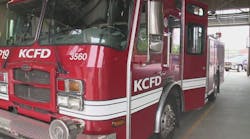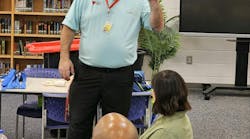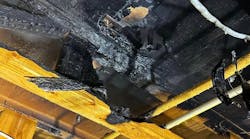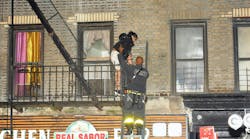Most model codes do not require the homeowner to upgrade their placement of alarms at this point.
The fire service is determined to beat the fire problem in the United States. The public looks to us to be the expert in issues that relate to fire concerns. We have a great asset in our responding crews and can be the biggest advocate in making sure every home has working smoke alarms.
Think about all of the medical runs and services calls a fire department will go on in a given year. What if every person on the crew observed the conditions in the home and made sure to test the smoke alarms before they leave the scene?
For instance, Engine 31 is dispatched to assist EMS on a medical emergency. The engine responds and assists EMS in performing medical care. The patient is loaded into the ambulance and the EMS crew transports the patient to the hospital. The engine crew works to secure their equipment and gives directions to the spouse on how to get to the hospital. This scene plays out thousands of times in a day.
What if we expand the response and the driver of Engine 31 decides to evaluate the surroundings? After the patient has been loaded, the driver of the engine decides to test the smoke alarms in the home and finds that they are missing a battery. The driver then goes back to the apparatus, grabs a spare battery, and places a new battery into the smoke alarm.
This simple five minute check has possibly saved the lives of that family. Think about the number of smoke alarms that can be evaluated during a given day if every fire company did that simple check. Although this is only one aspect, there are many others that affect the installation of smoke alarms.
The model building codes require smoke alarms to be installed in all new homes. The smoke alarms are required to be installed:
- On every floor,
- Outside every sleeping area, and
- In each sleeping room (bedrooms).
In new construction the smoke alarms will be hard-wired (receiving power through 110-volt wiring) with a battery back-up. The smoke alarm is also interconnected which means that when one smoke alarm goes off they all do.
These are the requirements for new construction, what about existing buildings? Existing buildings have different requirements based on the adopted building and fire codes. Lets just make this simple, if there is home in must have smoke alarms. If they are not hard-wired, then a battery power alarm must be installed. Companies are now making available wireless smoke alarms so older homes with battery back-up smoke alarms can now be interconnected wirelessly.
Some common questions for smoke alarms include:
- When should I replace my batteries?
Smoke alarms require routine maintenance. Smoke alarm batteries should be replaced every six months (hence the "change your clock, change your batteries" campaign). A common misconception is that if your smoke alarms are hard-wired, then you don't need to change your batteries. One consideration is that many current manufacturer installation instructions allow the batteries to be replaced yearly. If you are not certain on your manufactures requirements, replace the battery every six months. - Do I have to replace my smoke alarms?
The National Fire Protection Association recommends that smoke alarms are replaced every 10 years. Most model codes do not require the homeowner to upgrade their placement of alarms at this point. As a fire service we should encourage people to upgrade to the current provisions of the code. Older homes may only have one smoke alarm in the area outside the bedrooms. This is a great chance to recommend that smoke alarms be installed in all currently required areas. Another great option is to recommend interconnecting the smoke alarms either through hard wiring or the use of wireless technology. - What type of smoke alarm do I need to install?
Currently there is much debate over the type to install. We encourage you to listen to the Fire Marshal's Corner podcast, on Radio@Firehouse, to have a better grasp on the issue. The important aspect is every home shall have a working smoke alarm.
There are specific installation guide lines found in NFPA 72 and the manufacture installation instruction. These documents discuss the proper location on a wall, ceiling, and locations when the ceiling may be pitched.
We encourage you to make a difference today and look out for your community on every run and every interaction with the public.
Related Links
- The National Fire Protection Association (NFPA)
- Kidde Wireless Systems
- U. S. Fire Administration's Smoke Alarms Webpage
- Fire Marshal's Corner: Photoelectric or Ionization Smoke Alarms - Which is the Right One?
- Fire Marshal's Corner: Photoelectric or Ionization Smoke Alarms - Part 2
- NFPA 72: National Fire Alarm Code
- U.S. Consumer Product Safety Commission Smoke Alarm Page
- Underwriters Laboratories Smoke Alarm Webpage
MICHAEL O'BRIAN, is a fire marshal for the Brighton Area Fire Authority in Michigan. His 10-year career in code administration and enforcement has spanned across the public and private sector and he has a B.S. in public safety administration from Eastern Michigan University. Brian is the president of Code Savvy Consultants and is the creator of the dynamic webpage www.inspector911.com that is designed to assist all types of inspectors by providing resources, information, checklists and up-to-date news. To read Michael's complete biography and view his archived articles, click here. You can reach Larry by e-mail at [email protected]..





